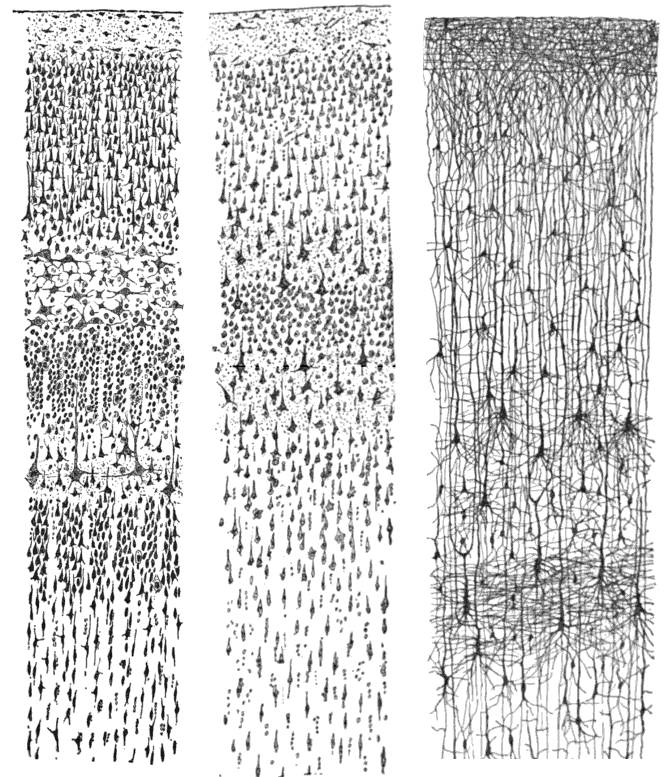3.1: Introduction
Imagine trying to string words together into a meaningful sentence without knowing the meaning of each word or its function (i.e., Is it a verb, noun, or adjective?). Similarly, to appreciate how groups of cells work together in the brain, we must first understand how individual cells in the brain function. Much like words, brain cells, called neurons, have an underlying structure that provides the foundation for their functional purpose. Have you ever seen a neuron? Did you know that the basic structure of a neuron is the same whether it is from the brain of a rat or a human? How do the billions of neurons in our brain allow us to do all the things we enjoy, such as chatting with a friend, cheering on a sports team, or laughing?

Our journey into these questions begins more than 100 years ago with a scientist named Santiago Ramón y Cajal. Cajal (1911) boldly concluded that discrete individual neurons are the structural and functional units of the nervous system. He based his conclusion on the numerous drawings he made of Golgi-stained tissue, a stain named after the scientist who discovered it, Camillo Golgi. Scientists use several types of stains to visualize cells. Each stain works in a unique way, which causes them to look different when viewed under a microscope. For example, a Nissl stain labels only the main part of the cell (i.e., the cell body; see left and middle panels of Figure 1). In contrast, a Golgi stain fills the cell body and all the processes that extend from it (right panel of Figure 1). Most notably, a Golgi stain only stains approximately 1–2% of neurons (Pasternak & Woolsey, 1975; Smit & Colon, 1969), permitting the observer to distinguish one cell from another. These qualities allowed Cajal to examine the full anatomical structure of individual neurons for the first time. This significantly enhanced the appreciation of the intricate networks their processes form. Based on his observation of Golgi-stained tissue, Cajal suggested neurons were distinct individual units rather than continuous structures. This opposed the dominant theory at the time proposed by Joseph von Gerlach, which stated that the nervous system was composed of a network of long continuous fibers, like telegraph wires (for review see Lopez-Munoz et al., 2006). Camillo Golgi himself had been an avid supporter of Gerlach’s theory. Despite their scientific disagreement, Cajal and Camillo Golgi shared the Nobel Prize for Medicine in 1906 for their combined contribution to our understanding of neurons. This seminal work paved the way for our current understanding of the basic structure of the nervous system described in this chapter (for reviews see: De Carlos & Borrell, 2007; Grant, 2007).
This chapter first introduces some basic terminology and the anatomy of neurons in the section “The Structure of the Neuron.” The remainder of the chapter focuses on the electrochemical signals through which neurons communicate. While the electrochemical process might sound intimidating, it is broken down into manageable sections. The first subsection, “Resting Membrane Potential,” describes what occurs in a neuron at rest, when it is theoretically not receiving or sending signals. Building upon this, we examine the electrical conductance within a single neuron when it receives signals. Finally, the chapter concludes with a description of the electrical conductance, which results in communication between neurons through a release of chemicals. At the end of the chapter, you should have a broad understanding of how neurons send and receive information by electrical and chemical signals.
A note of encouragement: This chapter introduces a vast amount of terminology that at times may feel overwhelming. Do not get discouraged or bogged down in the details. Utilize the book’s glossary, which contains all terms in bold typing. On your first read of this chapter, try focusing on the broader concepts and functional aspects of the terms instead of trying to commit all the terminology to memory. I suggest reading this chapter at least twice, once before and once after the course lecture on this material. Repetition is the best way to gain clarity and commit to memory the challenging concepts and detailed vocabulary presented here.
Media Attributions
- Cajal cortex drawings © Santiago Ramón via wikimedia is licensed under a Public Domain license

